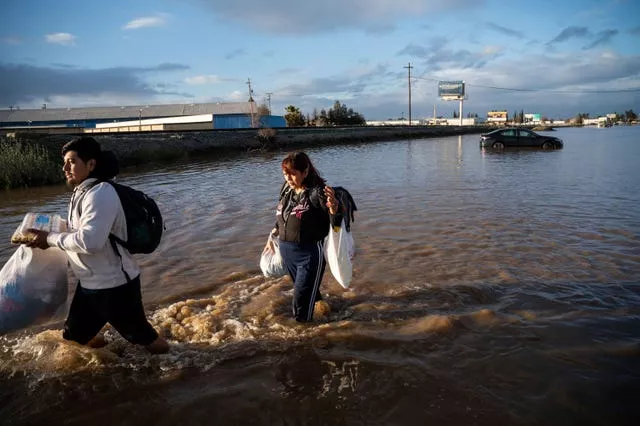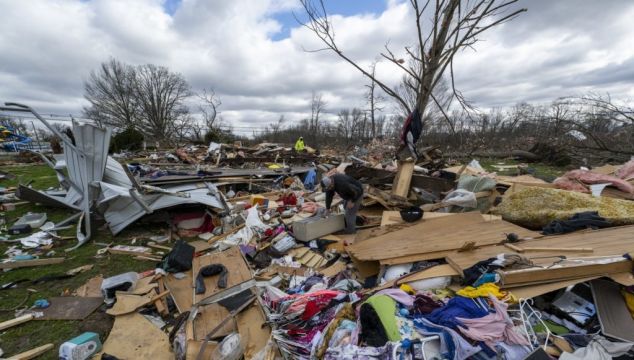The United States is Earth’s punching bag for nasty weather – and its geography is to blame, according to experts.
The nation is getting hit by stronger, costlier, more varied and frequent extreme weather than anywhere on the planet, with two oceans, the Gulf of Mexico, the Rocky Mountains, jutting peninsulas like Florida, clashing storm fronts and the jet stream combining to naturally brew the nastiest of weather.
But while nature dealt the United States a bad hand, experts say people have made it much worse by what, where and how they build.
Add climate change to the mix, and Rick Spinrad, head of the National Oceanic and Atmospheric Administration, warned: “Buckle up. More extreme events are expected.”

While huge swathes of the country currently deal with devastation caused by a series of massive, powerful tornadoes, other parts have in recent times endured hurricanes, flash floods, droughts, wildfires, ice storms, heatwaves, monsoons, and the dreaded polar vortex.
It starts with “where we are on the globe”, North Carolina state climatologist Kathie Dello said. “It’s truly a little bit… unlucky.”
China has more people, and a large land area like the United States, but “they don’t have the same kind of clash of air masses as much as you do in the US that is producing a lot of the severe weather”, another expert – Susan Cutter of the Hazards Vulnerability and Resilience Institute at the University of South Carolina – said.
The US is by far the king of tornadoes and other severe storms.
“It really starts with kind of two things,” said Victor Gensini, a Northern Illinois University meteorology professor. “Number one is the Gulf of Mexico. And number two is elevated terrain to the west.”

Look at Friday’s deadly tornadoes, and watch out for the next week to see it in action: Dry air from the west goes up over the Rockies and crashes into warm, moist air from the Gulf of Mexico, and it is all brought together along a stormy jet stream.
In the west, it is a drumbeat of atmospheric rivers. In the Atlantic, it is nor’easters in the winter, hurricanes in the summer and sometimes a weird combination of both, like Superstorm Sandy.
Mr Spinrad said: “It is a reality that regardless of where you are in the country, where you call home, you’ve likely experienced a high-impact weather event first-hand.”
Killer tornadoes in December 2021 that struck Kentucky illustrated the uniqueness of the United States.
They hit areas with large immigrant populations. People who fled Central and South America, Bosnia and Africa were all victims.
A huge problem was that tornadoes did not occur in those people’s former homes, so they did not know what to watch for or what to do, or even know they had to be concerned about tornadoes, said Joseph Trujillo Falcon, a social scientist who investigated the aftermath.

With colder air up in the Arctic and warmer air in the tropics, the area between them – the mid-latitudes, where the United States is – gets the most interesting weather because of how the air acts in clashing temperatures, and that north-south temperature gradient drives the jet stream, said Northern Illinois meteorology professor Walker Ashley.
Then add mountain ranges that go north-south, jutting into the winds flowing from west to east, and underneath it all the toasty Gulf of Mexico.
The Gulf injects hot, moist air underneath the often cooler, dry air lifted by the mountains, “and that doesn’t happen really anywhere else in the world”, Mr Gensini said.
If the United States as a whole has it bad, the South has it the worst, said University of Georgia meteorology professor Marshall Shepherd, a former president of the American Meteorological Society.
“We drew the short straw (in the South) that we literally can experience every single type of extreme weather event,” he said. “Including blizzards. Including wildfires, tornadoes, floods, hurricanes. Every single type… There’s no other place in the United States that can say that.”

Florida, North Carolina and Louisiana also stick out in the water so are more prone to being hit by hurricanes.
The South has more manufactured housing that is vulnerable to all sorts of weather hazards, and storms are more likely to happen there at night. Night storms are deadly because people cannot see them and are less likely to take cover, and they miss warnings in their sleep.
The extreme weather triggered by America’s unique geography creates hazards. But it takes humans to turn those hazards into disasters, Mr Ashley and Mr Gensini said.
Just look where cities pop up in America and the rest of the world: near water that floods, except maybe Denver, said Ms Cutter. More people are moving to areas, such as the South, where there are more hazards.

“One of the ways in which you can make your communities more resilient is to not develop them in the most hazard-prone way or in the most hazard-prone portion of the community,” Ms Cutter said.
“The insistence on building up barrier islands and development on barrier islands, particularly on the East Coast and the Gulf Coast, knowing that that sand is going to move and having hurricanes hit with some frequency… seems like a colossal waste of money.”
Construction standards tend to be at the bare minimum and less likely to survive the storms, Mr Ashley warned.
“Our infrastructure is crumbling and nowhere near being climate-resilient at all.
Poverty makes it hard to prepare for and bounce back from disasters, especially in the South, the experts said, and that vulnerability is an even bigger issue in other places in the world.
“Safety can be bought,” Mr Ashley said. “Those that are well-to-do and who have resources can buy safety and will be the most resilient when disaster strikes.
“Unfortunately that isn’t all of us.”







